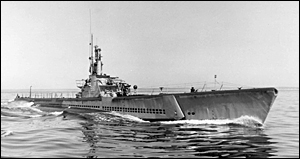Z Plan
- How did the Allies react when they first discovered the Z Plan documents were written in plain Japanese?
- What was the significance of Guam in the Pacific theater during WWII?
- How did the occupation of Guam by the Chammoros affect the island's political status in the 20th century?
- How did the end of WWII in Europe impact the Pacific theater?
- What was the role of Mineichi Koga in the Imperial Japanese Navy during WWII?

Photo of The USS Crevalle, the submarine that brought the Z Plan documents from the Philippines to Australia on May 11, 1944.
When the Z Plan documents were translated in Australia, Allied translators were amazed to discover the documents were written in plain Japanese, without encoding. The Preamble read:
The Combined Fleet is for the time being directing its main operations to the Pacific Area where, in the event of an attack by an enemy Fleet Occupation Force, it will bring to bear the combined maximum strength of all our forces to meet and destroy the enemy, and to maintain our hold on vital areas. These operations will be called "Z Operations.
Guam
The Mariana Islands were colonized by Spain in the 17th century and named after Spanish Queen Maria Anna. Guam, the largest of the Mariana Islands, became a U.S. territory in 1898 after the Spanish-American war, with the remaining Islands sold to Germany. After WWI, the League of Nations awarded all of Germany’s territories in the Pacific Ocean north of the Equator to Japan.
Japanese soldiers brought native Northern Mariana Chamorro people to Guam to help with the occupation. The occupation of Guam by the Chammoros is a major reason why Guamanians rejected a reunification referendum in the 1960s that was approved by the Northern Mariana Islands. Today, the Northern Mariana Islands are a commonwealth of the U.S., while Guam is a Territory with lesser congressional representation.
Pacific Victory
Prime Minister Hideki Tojo resigned July 22, 1944. On April 12, 1945 President FDR died, and Harry Truman became president. Later that month Benito Mussolini was killed, and Hitler committed suicide. The next week, WWII had ended in Europe, which allowed the Allies to shift their full attention and resources to the Pacific theater for a swift swing of victories.

Photo of Mineichi Koga 古賀 峯 (1885-1944), the commander-in-chief of the Imperial Japanese Navy's Combined Fleet.
Replica source: U.S. Army Lt. Col. James M. Cushing, radioed General MacArthur on April 9, 1944, about his worsening situation. National Archives. Records of General Headquarters, Southwest Pacific Area and United States Army Forces, Pacific (World War II), Record Group 496. Online Text.
Limited Distribution Translation No. 4 gave American commanders their first look at Japan's Z Plan. National Archives, Records of General Headquarters, Far East Command, Supreme Commander Allied Powers, and United Nations Command, Record Group 554,








